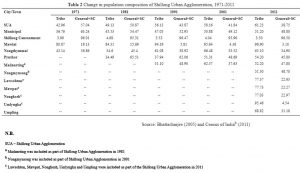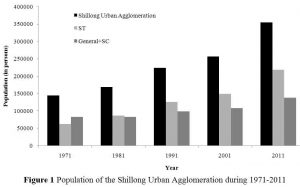Bhogtoram Mawroh
Shillong came into prominence when the British made it headquarter of the newly formed province of Assam in 1872. This encouraged the migration of scores of Bengalis for jobs in clerical positions who gradually settled in different parts of the town. As the town grew other non-tribal communities like Nepali, Marwari, Punjabi, Sindhi and Bihari gradually started arriving in search for livelihood opportunities11. While the Nepalis, initially came as soldiers and later settled down to work as graziers and herdsmen in the hill slopes, the Marwaris, Sindhis and Biharis came primarily for establishing business and soon began to control and occupy the important commercial areas in the State. By 1931, Shillong became the number one town of Assam in terms of population. Post-Independence, a small number of affluent Assamese families also started arriving in the town to take advantage of the job opportunities and educational facilities. Another round of migration occurred with the establishment of the Eastern Air Command after Indo-China War of 1962 leading to a heavy influx of armed forces into the area. Shillong continued to expand after Meghalaya achieved statehood in 1972 with the expansion of the bureaucracy and establishment of Central Government institutions like the North Eastern Hill University, North Eastern Council, North Eastern Electrical Power Corporation, etc.12 The last instance of large scale migration took place when Bengali refugees from Sylhet were settled in different parts of the City after the outbreak of the Bangladesh Liberation War in 1971.13 All these resulted in the high concentration of non-tribal population in Shillong. However, the claim that migration from outside is still continuing at a rapid rate and many parts of the City have experienced a decline in tribal population is highly misleading.
In 1971, apart from Shillong Cantonment and the areas under the Municipal, only Mawlai and Nongthymmai were a part of the Shillong Urban Agglomeration (SUA). Around this time the Schedule Tribe made up for just over 40% of the total population. Other areas were included in the subsequent decades. During the same period, 1971-2011 the proportion of Schedule Tribe population also increased from around 43% (1971) to more than 60% (2011) of the total population (See Figure 1). This was partly due the fact that many of the new towns that were brought under the SUA already had a very high ST population (>50% to more than >90%). The more important reason though is the decrease in the share of non-tribal population in areas in which they were previously a majority. So, if one closely looks at the demographic data reduction of non-tribal population (due to ethnic violence and discriminatory policies) rather than influx has been the case. But in everyday conversation and political rhetoric it is the opposite which is expounded and pushed forward as an agenda particularly during election times.
The threat that unabated immigration is leading to indigenous groups becoming marginalized is echoed by other ethnic groups in the region.14 This performs the function of legitimizing the (false) narrative of influx into the State. Another reason is that in everyday experience it is not proportional but absolute figures which influence public perceptions and decision-making. The share of the non-tribal population has indeed gone down over the years. But in absolute terms, the non-tribal population has increased from 1, 97,484 in 1971 to 4, 10,515 persons in 2011. The same is true in the case in Shillong where the decrease in proportion has not been accompanied by a decrease in the absolute numbers (See Figure 1). The latter is what the tribal people see as an evidence of rising influx and the existing high preponderance of non-tribal population in the City are taken as an evidence of it. The state of Meghalaya was founded on the need to fulfil tribal aspirations. Massive corruption and high levels of underdevelopment15 has meant that an increasing non-tribal population (in absolute terms) is seen as a threat to members of the tribal population competing for limited opportunities. In the formal sector (public sector employment), the State Reservation Policy ensures that non-tribal participation is strictly regulated (80% of the seats are reserved for Khasi-Jaintia and Garo). But the informal sector (like street trade) is not properly regulated and this, it is argued, has allowed outsiders (i.e., non-tribals) to infiltrate and settle down in the State.
On August, 2017 the KHNAM (Khun Hynniewtrep National Awakening Movement), erstwhile political offshoot of the Khasi Students Union, filed an RTI query with the Urban Affairs Department about the legal status of many of the hawkers who were plying their business on the footpaths of the main commercial areas of the city. They claimed that most of them are illegal immigrants and street trade is providing them with the opportunity to settle in the State. However, membership records of the largest street vendors association of Meghalaya, Meghalaya and Greater Shillong Progressive Hawkers and Street Vendors Association (MGSPHSVA) revealed that almost 2/3rd of the vendors in Shillong belong to the Khasi-Jaintia community, majority of them being female.
Table 2 Change in population composition of Shillong Urban Agglomeration, 1971-2011

Source: Bhattacharjee (2005) and Census of Indiab (2011)
N.B.
SUA – Shillong Urban Agglomeration
a Madanrting was included as part of Shillong Urban Agglomeration in 1981
b Nongmynsong was included as part of Shillong Urban Agglomeration in 2001
c Lawsohtun, Mawpat, Nongkesh, Umlyngka and Umpling were included as part of the Shillong Urban Agglomeration in 2011

Figure 1 Population of the Shillong Urban Agglomeration during 1971-2011
In 2019 The KHADC (Khasi Hills Autonomous District Council) took out a drive to check non traders doing business without obtaining license led to a lot of shops being closed down. One such shop was from Nongmynsong. It was a food shop which I would frequent with my friend. The people who ran the business were from Sikkim and were probably Bhutia. Because of the large number of Nepali residents in the area they were encouraged to set up shop in the area. After since the inspection the particular shop has remained closed with the owners presumably returning to their home state. Cases like these rouse the suspicion of the local pressure groups who argue that if not stopped this will encourage more migration. The long term trend of Nongmynsong actually proves otherwise. Being a resident of the town, I remembered it having a very sizeable non-tribal population in the past. But ever since the 1997 riots there has been a demographic change. A lot of tribals have come to settle in recent years. Some have bought land and build houses for themselves while others have raised buildings for giving it on rent. Limited to only meat and vegetable sellers, tribal participation in local trade has also experienced a change. The biggest convenience store in the town is owned and manned by tribals. With time more of the business will be dominated by the tribals. You will still have instances of non-tribals (from outside the State) attempting to evade the law but these will be an exception rather than the rule.
CAA has thrown a spanner on this historical process whereby old fears are being more venom. The state has been trying to move on from the anti-immigrants fear and the heady days of violence against the non-tribals. Granted there are instances when the issues get revived and emotions inflamed. They though happen just before elections and die out immediately afterwards. In the meantime, tribal consolidation goes on with increasing acceptance of the non-tribal presence. Last Assembly elections there was the public call for garnering genuine non-tribal votes which I don’t remember being the case many years ago.
As the data shows, even without ILP, Non Tribal population percentage in Meghalaya has been decreasing over the years. Local land laws, reservation policy and sixth schedule protections have dis-incentivised non-tribal migration. It is mostly the labour brought into the state by mostly Tribal businessmen and contractors for infrastructural projects and mining that is the ongoing source of migration. ILP in such cases of labour movement won’t really stop migration as the examples from ILP states of Nagaland and Arunachal Pradesh makes it amply clear. The situation in Meghalaya is very different from Assam because unlike Meghalaya, many areas in Assam do not have constitutional protections for the indigenous people, so demographic fallout from CAA will be a much slower process in Meghalaya.
Thus policy response of Meghalaya has to be more contextual and deliberative rather than what happened recently when owing to public pressure from a section of the people, the state government in a hurry and without proper pre-legislative consultation passed a resolution to request the Union Govt to extend ILP provisions to Meghalaya. But nod from the centre does seem to be coming and now other indigenous voices examining the ramifications of ILP have also started being voiced. While opposition against CAA has to be intensified while strong measures to protect indigenous tribal groups also needs to continue, it is also vitally important to understand the complexity that surrounds the case of Meghalaya and remove propaganda from truth (Concluded).
(This article is published by arrangement with Raiot where it first appeared @ “https://www.raiot.in/“
References
1Shimray, U.A., and Ramana, M. V., (2008). ‘Uranium Mining in Meghalaya: Simmering Problem’, Economic and Political Weekly, Vol. 42, No. 52, pp.13-17.Karlsson, Bengt G. (2009). ‘Nuclear Lives: Uranium Mining, Indigenous Peoples, and Development in India’, Economic and Political Weekly, Vol. 44, No. 34, pp. 43-49.
2Sirnate, Vasundhara (2009). ‘Students versus the State: The Politics of Uranium Mining in Meghalaya’, Economic and Political Weekly, Vol. 44, No. 47, pp. 18-23.
3Haokip, Thongkholal (2014). ‘Inter-ethnic relations in Meghalaya’, Asian Ethnicity, Vol. 15, No. 3, pp. 302-316.
4TNT (2017). Meghalaya: KSU burns effigies of UCIL & AMD on Khasi National Awakening Day 2017, The North East Today.
5Nongbri, T. (2000). ‘Khasi Women and Matriliny: Transformations in Gender Relations’, Gender, Technology and Development, Vol. 4 No. 3, pp. 359–395.
6Nongbri, T. (2000). ‘Khasi Women and Matriliny: Transformations in Gender Relations’, Gender, Technology and Development, Vol. 4 No. 3, pp. 359–395.
7Rafy, KU (1920). Folk Tales of the Khasis. London: Macmillan and Company.
8Haokip, Thongkholal (2014). ‘Inter-ethnic relations in Meghalaya’, Asian Ethnicity, Vol. 15, No. 3, pp. 302-316.
9Philippe Ramirez (2014). People of the Margins: Across Ethnic boundaries in North-East India. Spectrum Publication, Guwahati, Delhi.
10Nongbri, T. (2000). ‘Khasi Women and Matriliny: Transformations in Gender Relations’, Gender, Technology and Development, Vol. 4 No. 3, pp. 359–395.
11Gupta, Surojit Sen (2003). Urban social structure: a study of urbanization in Shillong, Unpublished PhD Thesis, Shillong: Department of Sociology, North Eastern Hill University.
12Gupta, Surojit Sen (2003). Urban social structure: a study of urbanization in Shillong, Unpublished PhD Thesis, Shillong: Department of Sociology, North Eastern Hill University.
13Mukhim, Patricia Mary (2007). ‘Turbulence in the Abode of Clouds: Militant Resurgence in Meghalaya’, in Frontier in Flames: North East India in Turmoil, edited by Jaideep Saikia, pp. 1–13, New Delhi: Penguin Books.
14Shimray, U.A. (2001). ‘Ethnicity and Socio-Political Assertion: The Manipur Experience’, Economic and Political Weekly, Vol. 36, No. 39, pp. 3674-3677.
15Government of India (2013). Report of the Committee for Evolving a Composite Development Index of States. New Delhi: Ministry of Finance, Government of India.



